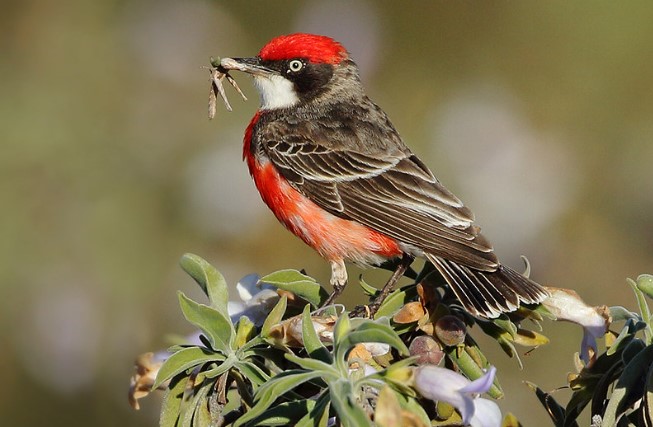Family: The Crimson Chat (Epthianura tricolor) is a fascinating bird species of the family Meliphagidae that is native to Australia’s arid zone. As a nomad, it roams the region in search of food and water, following the erratic rains that sustain it.

Behavior: The Crimson Chat is known to travel in flocks of tens to hundreds of individuals and prefers scrubland areas, such as welt-shrubbed mulga, acacia, and mallee. Its movements tend to be northward during the autumn and winter months, while in the spring and summer, it migrates southward to breed. However, there are numerous fluctuations and erratic interruptions in their behavior.
Habitats: The Crimson Chat’s feeding habits mainly involve ground foraging, where flocks of birds quickly work through a patch of scrubland. They run and pick up insects and then suddenly take flight as a group to fly a distance of 100 meters or more to the next site, in swift jerky, undulating flight. The bird species also occasionally sweeps nectar from ground-flowering herbs using their short-brushed, honeyeater-like tongues.
It is a hint that they have probable ancestry related to honeyeaters. Crimson Chats drink water whenever they can, taking only fresh water and even gleaning dew from leaves. The bird species has a more economical body water balance and lower metabolic rate than the White-fronted Chat, and it breeds later into the warmer months than the latter, indicating that it is a better desert-adapted bird.
During the non-breeding season, male Crimson Chats appear dull and mottled like the females. However, during breeding, they develop vivid red crowns and breasts. These nuptial plumages, gained through a second annual body molt, are rare in Australian passerines and are matched only in two other chats: the White-winged Triller, Brown Songlark, and fairy-wrens. Crimson chats often nest in loose colonies, within which the male defends first his mate and then their territory, which covers an area of about 20 meters.
To advertise himself to a potential mate, the male flies from one side of a bush to the other, climbing steeply and puffing out his colored underparts while uttering a vigorous, oscillating call. Then at the top, he folds his wings and glides down to a tee-whee call, levels off, and lands. Intruders are chased off in long flights lasting for 20 seconds or more, well beyond the territorial boundary.
Courtship: In courtship, the male Crimson Chat swoops towards the female with his wings and tail spread and the crown raised. He accompanies her as she collects material, constructs the nest, and assists her in incubation and feeding the young. If the nest is threatened, both flutter to the ground, feigning injury. After the young fledge, neighboring families may group together, and flocks may re-form.
Subspecies: The male red-capped robin, known scientifically as (Petroica goodenovii), is often mistaken for the crimson chat, but there are several distinct differences between the two species. The male crimson cat has a red crown and underparts, a white throat, and a yellow eye, while the red-capped robin has a black body with a crimson chest and cap, white wing markings, and a dark eye. In addition, the crimson chat’s bill is longer and more slender than that of the robin. Observing a crimson chat is a good indication that saltbush, Spinifex, or mulga plants are nearby, as they are often associated with this bird species. The conservation status of the crimson chat is secure, according to relevant federal and NSW, with the only significant threat being predation.
OTHER NAMES: Crimson-breasted Nun, saltbush canary, and Tricolour Chat.
LENGTH: The size of the bird is about 110–120 mm in length and 10–11 g (0.35–0.39 oz) in weight.
IDENTIFICATION: Here are a few tips of identification
MALE: Crown scarlet; hind-neck and back dark brown; rump scarlet. Wing feathers are brown-black with white edges; tail feathers are brown-black with white spots on the inner web of each feather at the tip, except the middle pair. The face is dusky, while the throat is white; and the rest of the underparts are scarlet, becoming white under the tail. Eyes are cream-yellow. Bill has an upper mandible black, lower light horn. Feet are slate-grey in color.
ECLIPSE MALE: As female but forehead washed red; breast blotched more heavily red.
Female: wings, rump, and tail as male. Head and back are plain mid-grey-brown. Underparts are white with irregular blotching of pale red over the breast.
IMMATURES: Crown, back, and edges of wing feathers light brown; rump orange-red; underparts white, washed buff-brown on breast and flanks. Eye light brown.
Voice: A common call is probably in contact and is a high, silvery, chiming swee, usually repeated three to six times. Soft dik-it, dik-it or brisk chek, chek in flight, also in contact. SONG: Harsh oscillating rattles and silvery trills.
NESTING: Breeds mainly from August to October in the south and is variable in the north. The nest is a cup made of fine dry grass, fine twigs, and plant stalks, lined with fine rootlets and hair, usually 100–750 mm above ground in saltbush, grass tussock, forb, or similar low cover. The eggs are oval, about 17 x 14 mm, and are white, scattered with red-black, purplish, and grey spots, particularly at the larger end, with three or four eggs laid. Incubation is done by both sexes and lasts for 12 days. The young fledged in about 14 days.
DISTRIBUTION: The species can be found in scrubby shrub savanna and tree savanna of inland plains, and during coastward irruptions, they may enter cultivated areas and gardens. They are nomadic and do not have races.
FINAL REMARKS: The Crimson Chat is a remarkable bird species that is well-adapted to life in Australia’s arid zone. Its gregarious behavior, unique feeding habits, and stunning nuptial plumage make it a fascinating bird to observe. It is a testament to the adaptability and resilience of nature that such a species can thrive in one of the harshest environments on the planet.
Read More: Painted Firetail (Emblema pictum)
